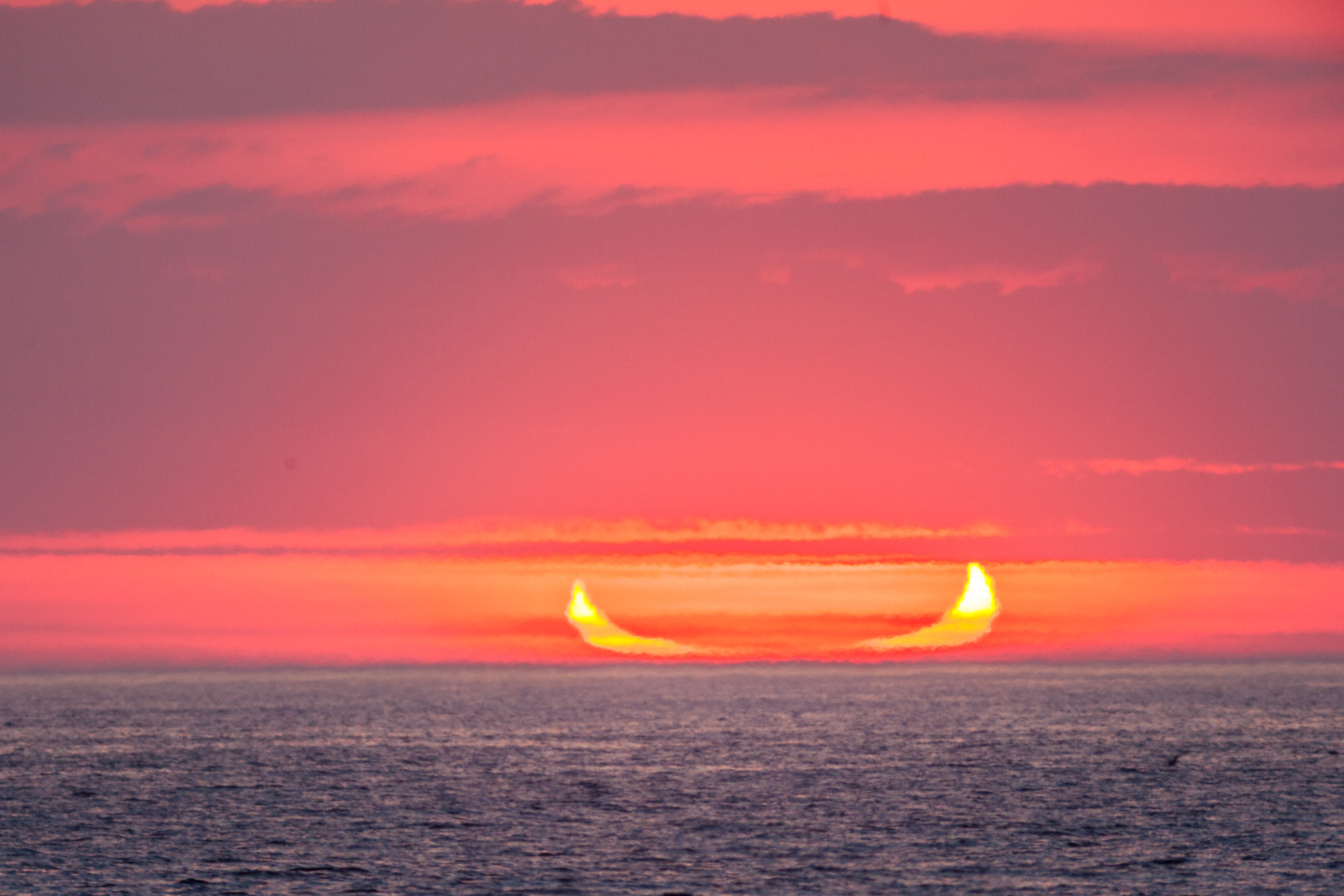Navigation
Install the app
How to install the app on iOS
Follow along with the video below to see how to install our site as a web app on your home screen.
Note: This feature may not be available in some browsers.
More options
You are using an out of date browser. It may not display this or other websites correctly.
You should upgrade or use an alternative browser.
You should upgrade or use an alternative browser.
The Night Sky
- Thread starter Roccus7
- Start date
wader
Well-Known Angler

An ancient star casts new light on the birth of the universe
Astronomers have discovered an exceedingly old star at the edge of our galaxy that seems to have formed only a few million years after the Big Bang.
He said SPLUS J2104−0049 – a red giant star with about 80 percent of the mass of the sun – is at least 10 billion years old and possibly just a few million years younger than the universe itself, which astronomers estimate is 13.8 billion years old.
China’s Mars rover touches ground on red planet
Associated Press May 22, 2021

BEIJING — China’s first Mars rover has driven down from its landing platform and is now roaming the surface of the red planet, China’s space administration said Saturday.
The solar-powered rover touched Martian soil at 10:40 a.m. Saturday Beijing time (0240 GMT), the China National Space Administration said.
China landed the spacecraft carrying the rover on Mars last Saturday, a technically challenging feat more difficult than a moon landing, in a first for the country. It is the second country to land and operate a spacecraft on Mars, after the United States.
Named after the Chinese god of fire, Zhurong, the rover was running diagnostics tests for several days before it began its exploration Saturday. It is expected to be deployed for 90 days to search of evidence of life.
The U.S. also has an ongoing Mars mission, with the Perseverance rover and a tiny helicopter exploring the planet. NASA expects the rover to collect its first sample in July for return to Earth as early as 2031.
China has ambitious space plans that include launching a crewed orbital station and landing a human on the moon. China in 2019 became the first country to land a space probe on the little-explored far side of the moon, and in December returned lunar rocks to Earth for the first time since the 1970s.
Love it!! Will extend AM darkness for my bass fishing having an eclipsed sun rising...
wader
Well-Known Angler

This Exact Puzzle Was Apparently Given to 13- and 14-Year-Old Students as a Logic Test
Some scientists believe the universe is conscious. Sounds like a bad trip ... but what if it's true?
wader
Well-Known Angler
hell of read

 www.yahoo.com
www.yahoo.com

Does outer space end – or go on forever?
It can stretch your mind to ponder what's really out there. Stijn Dijkstra/EyeEm via Getty Images Curious Kids is a series for children of all ages. If you have a question you’d like an expert to answer, send it to [email protected]. What is beyond outer space? – Siah, age 11...
Damn that high-resolution photography...
Remember this 1976 photo of Mars and all the noise about it?

What a difference 30 years makes. Here's a 2006 photo of the same area, there went all the National Inquirer articles. The "Face" mesa from the above photo is in the lower right corner of the photo just to the right of the small crater.

Here's a closeup...

Remember this 1976 photo of Mars and all the noise about it?
What a difference 30 years makes. Here's a 2006 photo of the same area, there went all the National Inquirer articles. The "Face" mesa from the above photo is in the lower right corner of the photo just to the right of the small crater.
Here's a closeup...
Last edited:
Figured I'd watch Richard Branson blast off this morning until I saw who was hosting the broadcast. Oh well....

 www.space.com
www.space.com

Virgin Galactic will launch billionaire Richard Branson into space today. Here's how to watch it live.
Coverage starts at 10:30 a.m. EDT (1430 GMT).
Pretty cool image. I have a special place in my heart for M57, the first Messier Object I observed with my telescope...

Colors: Ring Nebula versus Stars
Image Credit: Robert Vanderbei (Princeton U.)
Explanation: What if you could see, separately, all the colors of the Ring? And of the surrounding stars? There's technology for that. The featured image shows the Ring Nebula (M57) and nearby stars through such technology: in this case, a prism-like diffraction grating. The Ring Nebula is seen only a few times because it emits light, primarily, in only a few colors. The two brightest emitted colors are hydrogen (red) and oxygen (blue), appearing as nearly overlapping images to the left of the image center. The image just to the right of center is the color-combined icon normally seen. Stars, on the other hand, emit most of their light in colors all across the visible spectrum. These colors, combined, make a nearly continuous streak -- which is why stars appear accompanied by multicolored bars. Breaking object light up into colors is scientifically useful because it can reveal the elements that compose that object, how fast that object is moving, and how distant that object is.
Colors: Ring Nebula versus Stars
Image Credit: Robert Vanderbei (Princeton U.)
Explanation: What if you could see, separately, all the colors of the Ring? And of the surrounding stars? There's technology for that. The featured image shows the Ring Nebula (M57) and nearby stars through such technology: in this case, a prism-like diffraction grating. The Ring Nebula is seen only a few times because it emits light, primarily, in only a few colors. The two brightest emitted colors are hydrogen (red) and oxygen (blue), appearing as nearly overlapping images to the left of the image center. The image just to the right of center is the color-combined icon normally seen. Stars, on the other hand, emit most of their light in colors all across the visible spectrum. These colors, combined, make a nearly continuous streak -- which is why stars appear accompanied by multicolored bars. Breaking object light up into colors is scientifically useful because it can reveal the elements that compose that object, how fast that object is moving, and how distant that object is.
wader
Well-Known Angler
video at the link

 www.yahoo.com
www.yahoo.com

Bright, loud fireball streaks across Texas sky, videos show. ‘Aliens have landed’
Some residents also reported hearing loud “booms” as the meteor roared past.
wader
Well-Known Angler

Saturn Is About to Be the Closest It Can Get to Earth on Aug. 2 - So Look Up!
In celestial news you needed, Saturn has entered the chat! The most beautiful planet in the sky will light up the night on Aug.
wader
Well-Known Angler

Astronomers see back of a black hole for first time, proving Albert Einstein was right
Astronomers have managed to look behind a black hole for the first time and have proved that Albert Einstein was right about how these mysterious celestial behemoths behave. An international team of researchers used high-powered X-ray telescopes to study a supermassive black hole 800 million...
Black holes are born when a gargantuan star explodes in a supernova and then collapses in on itself. This forms an incomprehensibly dense material which swallows up everything in its general vicinity, and therefore it should be impossible to see light from the back of a black hole.
However, Einstein’s dogmatic theory of general relativity predicted in 1915 that the gravitational pull of black holes is likely so enormous that they warp the very fabric of space, twisting magnetic fields and bending light.
As a result, Einstein’s work asserted that it should be possible to see light waves ejected from the far side of the black hole because of the distorted magnetic fields acting as a mirror.
wader
Well-Known Angler

An amateur astronomer spotted a new moon orbiting Jupiter
An amateur astronomer spotted a new moon orbiting Jupiter
wader
Well-Known Angler

‘Best meteor shower of year’ peaks this week. You may see 100 per hour — and fireballs
“The Perseids are one of the most plentiful showers.”
Members online
Total: 670 (members: 12, guests: 658)
Latest articles
-
Recreational Anglers Deserve an ApologyI've Been Saying This All Along: Recreational Anglers Deserve an Apology The data is finally in...
- george
- Updated:
- 6 min read
-
Abu Garcia's Beast SeriesAbu Garcia's Beast Series: Revolutionary Equipment for the Modern Swimbait Revolution October...
- george
- Updated:
- 6 min read
-
World's Lightest Spinning ReelGame-Changer or Gimmick? The Daiwa LUVIAS ST Claims to Be the World's Lightest Spinning Reel An...
- george
- Updated:
- 4 min read
-
New York Fluked Itself!Fluke Management in 2025: Regulators Got It Wrong Halfway through this season New York anglers...
- george
- Updated:
- 2 min read
-
Hunting Stripers and Blues from Rockaway Beach to Moriches InletThe Western Run: Hunting Stripers and Blues from Rockaway Beach to Moriches Inlet By: A Die-Hard...
- george
- Updated:
- 10 min read

